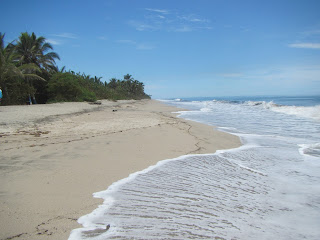 |
| Palomino beach |
 |
| Miles of beach in Palomino |
There was glorious sunshine every morning, and we even
had a view of the snow-capped Sierra Nevada mountains from the bottom of the
garden in our accommodation.
It's hard to believe that it's possible to see
snow up there when we were stood melting down at sea level, in extremely high
heat and humidity! It's apparently the highest peak in Colombia and you can just about make out the snowy peaks in my photo:
 |
| The snow capped peaks of the Sierra Nevada Mountains in the distance |
In the afternoon, the sunshine would eventually give way
to thunderstorms and torrential rain and the occasional power cut.
The main mud road of the town is characterised by several large puddles that fill the entire road, so it takes some time to get anywhere, picking your way around the puddles.
The main mud road of the town is characterised by several large puddles that fill the entire road, so it takes some time to get anywhere, picking your way around the puddles.
When it rains, we were recommended to just
go out barefoot to avoid the issue of soaking your trainers or losing a flip
flop in the mud!
We went 'tubing' down the river one day – a much more
sedate affair than in Laos – just floating down the river in a giant inner tube,
with views of the mountains, until we reached the sea. We just had to be sure
to get out before we floated out to sea!
 |
| Tubing in Palomino |
Getting to the start point however was a little hairier -
it basically involved getting on the back of a motorcycle taxi whilst carrying
our tubes!
All in all, Palomino was a lovely place to stay for a few
days. After four nights, we travelled down to Santa Marta, so we could do a day
trip into Tayrona National Park.
Once in the park, we embarked upon a six-mile hike along
the coast, which was tough as it was so hot and humid. It's also not possible
to swim on most of the beaches due to the strong currents and big waves so we
had to wait a while before we could cool off.
 |
| Tayrona National Park |
Most of the park has well organised trails with
boardwalks, but parts of the track are very muddy and we had to wade across
three shallow rivers in some parts – I think probably due to the heavy rain
that has been falling.
 |
| Rough seas in Tayrona Park |
After two hours of hiking, we eventually reached
Arricefes and there's a beach nearby where we could finally swim in a sheltered
bay – where cooling off was much appreciated. The park is stunning – wild beaches, huge boulders and big waves. Well worth the strenuous hiking effort.
 |
| Huge boulder cracked in half |
We are now down to our final week – how time flies! First
we’ll head back to Cartagena for a few days, then we fly to Mexico in
preparation for our flight back to London.
Tune in again next week for the final instalment of the
blog (well, for this trip anyway!)

















